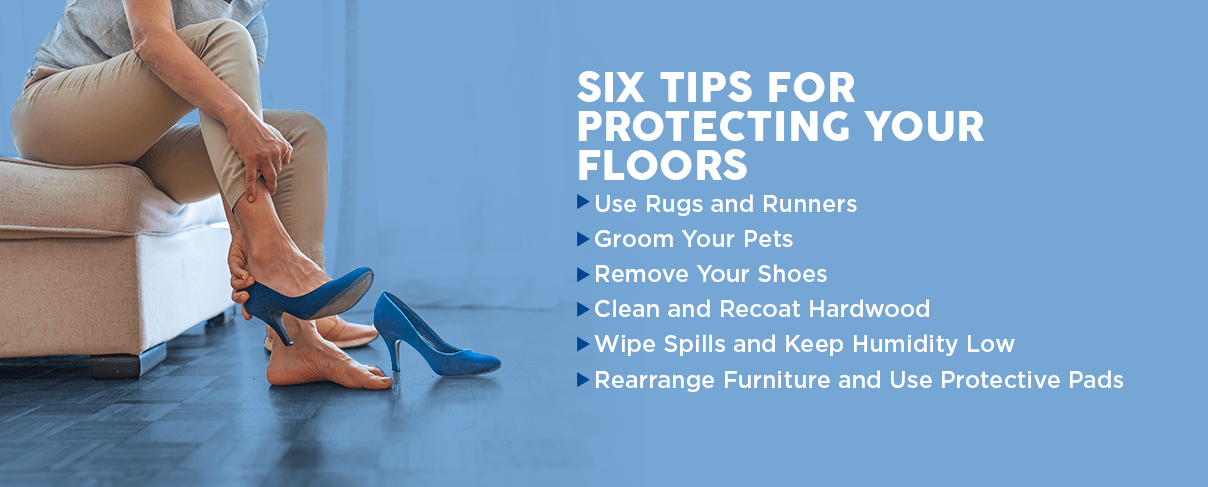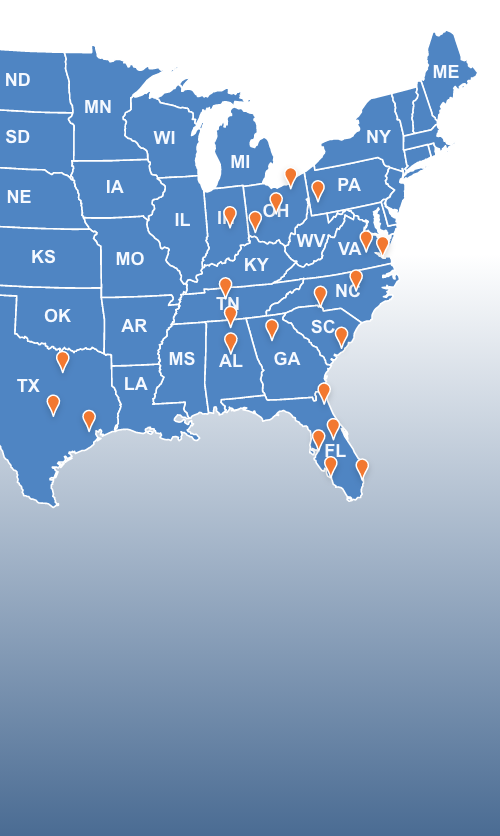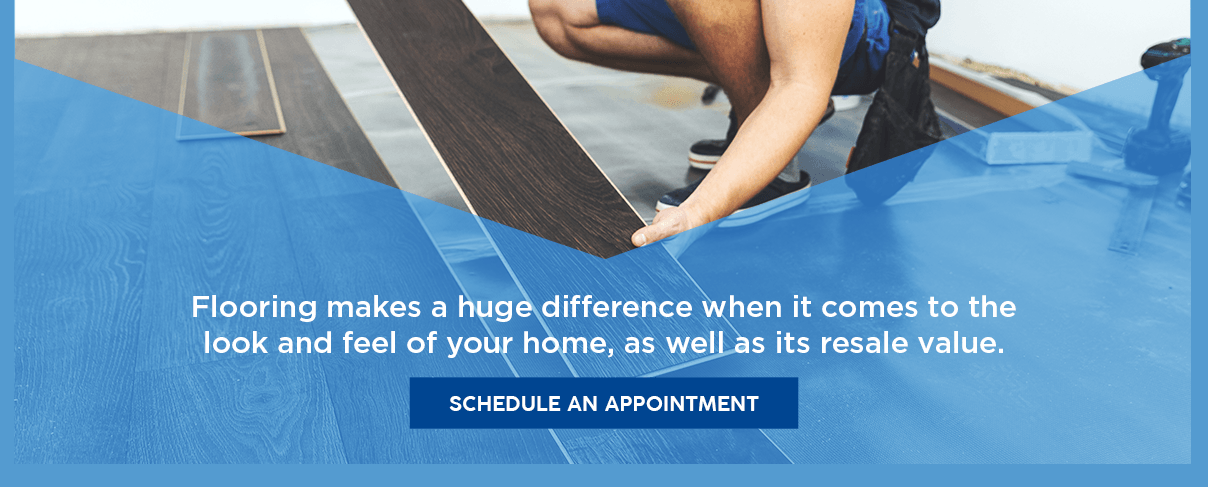

While you and your family spend more time at home, your floors withstand more wear and tear than ever before. As you know, kids and pets can do a lot of damage to a floor — scratching it with their toys, spilling things on it and tracking in dirt and mud. Heavy furniture, traffic and exposure to the elements can also take a toll on your floors. However, you can take several steps when it comes to protecting floors from damage. Follow the tips outlined below to protect your home’s floors.
Six Tips for Protecting Your Floors


You can take measures to avoid the extra wear and tear on your home’s floors. Several strategies will come in handy. Follow these six tips for protecting your floors while at home:
1. Use Rugs and Runners
When it comes to protecting flooring, area rugs and runners can be lifesavers. Rugs can help you avoid dents, scrapes and spills on your floor. Place open-back rugs on your floor’s high-traffic spots— hallways, entryways and kids’ play areas. A plush rug in your kids’ play area can also help cushion falls, minimizing injuries.
If you have hardwood floors, you’ll want to avoid rubber-back rugs, which can lead to built-up moisture. Be sure to wash your rugs often, as dirt trapped under a rug can scuff the floor. When you sweep or vacuum, remember to move your rugs aside and clean underneath them — and make sure you’ve cleaned the floor before you lay a rug down.
When deciding on the right area rug or runner to add to a room, consider the room’s feel and function. For instance, you might want a thicker, shaggier carpet under heavy furniture or in rooms where kids play. Be sure to measure the space, and keep in mind that large area rugs can make a room feel larger.
2. Groom Your Pets
Pets create the need for extra floor protection. As much as you love your pets, you know how destructive they can be! You have to protect your furniture and flooring from their claws, teeth, fur and spills. Pet damage is one of the fastest ways to decrease your floor’s lifespan. Area rugs, especially at entryways, can help minimize some damage, but it’s also important to groom your pets well.
Maintain your pets’ claws, trimming as needed. This will help limit the scratching that occurs as your pet scampers around your house. When it comes to cats, provide scratching posts rather than declawing — declawing a cat is inhumane, painful and anxiety-inducing. On the other hand, you can trim your dog’s nails at home. If the nail trimmer makes your dog anxious, provide some peanut butter or treats as a distraction and offer lots of praise.
3. Remove Your Shoes
It’s simple enough — take off your shoes to protect your floors! Wearing your shoes inside can track mud and dirt across your floor. This is especially true during the winter months — your floors take a beating as snowboots tramp in dirty snow and ice. In addition, high-friction shoes like cleats and high heels are likely to leave wear marks.
For these reasons, it’s a good idea to institute a shoes-off policy for your home. If you have a mudroom, perfect! If not, you can place a shelf or shoe rack by your entrance, with a mat underneath to catch dirt. You might want to keep a basket full of slippers and socks beside the shoe rack so you can offer your guests a comfortable alternative to their shoes.
4. Clean and Recoat Hardwood
Regular cleaning is a vital part of extending your floor’s lifespan. Be sure to sweep or vacuum your floors often, and follow the floor care guide for your flooring material. Hardwood floors require some special maintenance in addition to cleaning. If your home has hardwood floors, use a microfiber dust mop to remove dirt and debris. Remove wet spills as soon as possible using a wet vacuum and absorbent towels — moisture can do serious damage to a wood floor, causing warping as well as mold and mildew buildup.
You’ll also need to recoat and refinish to protect hardwood floors. Recoat before the finish is worn through, which can result in damage to the wood itself. Use appropriate recoating in different spaces. For instance, you’ll probably want to use a moisture-resistant coating in the kitchen. Less frequently, you may want to refinish your wood floors, removing and replacing all of the finish. If your wood floor has sustained serious damage, such as flooding from a burst pipe, you may have to refinish to prevent total floor replacement.
5. Wipe Spills and Keep Humidity Low
Water and moisture can cause flooring issues, so it’s important to clean up spills as soon as you can. Soak up wet spills right away. Use an odor removing spray for pet-related spills. In addition, be sure to keep the humidity in your home at a reasonable level. If you live somewhere muggy, you might want to use a dehumidifier.
6. Rearrange Furniture and Use Protective Pads
Traffic, pets and humidity are not the only culprits when it comes to floor damage. Your furniture can also cause plenty of issues for your floor. For instance, rolling a desk chair around can make a wood floor look like a cutting board, and heavy couches can leave permanent indents in your wall-to-wall carpeting. You can take a few steps to avoid these issues.
Use area rugs, protective pads and plastic mats under your furniture. This will help limit indentation and scuffing. It’s also a good idea to rearrange your furniture from time to time. Moving your furniture around will help even the floor’s exposure to light, moisture and traffic, so certain areas are not worn faster than others. Rearranging also helps you clean and maintain your entire floor. When rearranging furniture, be sure to lift both ends with a partner or place plywood underneath before pushing and pulling pieces around.
Contact 50Floor to Learn More
Flooring makes a huge difference when it comes to the look and feel of your home, as well as its resale value. Your floors can only handle so much traffic and wear — limit the damage by taking preventive measures and repair damage through regular maintenance. If you do, you’ll increase the lifespan of your home’s floors. To learn more about floor protection and maintenance, schedule an appointment with 50Floor today.




